There’s nothing more annoying than algae invading your aquarium. Luckily, if it’s out of control, there’s a simple solution for you that also makes for a beautiful tank.
There are aquatic animals that can eat their way through this outbreak. So here are the top 14 best algae eaters for your aquarium to help you control this plant invasion. These will clear your tank and are also a beautiful addition to your aquarium. It’s a win-win situation.
Also, it doesn’t matter what type of fish tank you have. We give you a selection of both the best freshwater algae eaters and the best saltwater algae eaters.
Each algae eater has a different body and mouth, so different types can eat different algae. So keep on reading to find out which one is adapted for the algae you have in your fish tank.
Let’s dive in, shall we?
Contents
6 Best Freshwater Algae Eaters
Here are the best freshwater algae eaters for all types of aquarium sizes and different algae.
Check out these other top picks:
1. Reticulated Hillstream Loach
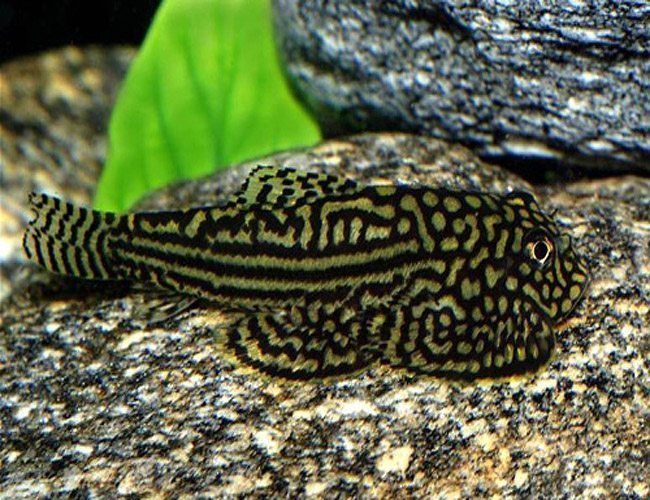
Not only is this a beautiful and unusual-looking fish, but this loach can also clean large and flat surfaces. Think of it as your personal window-washing fish.
It will eat any kind of flat algae in freshwater tanks, no matter if they’re on flat rocks, walls, or plant leaves. And this fish is stunning to look at.
Just be aware that this fish species can get a bit territorial, especially with its own, so only get one of them for your tank, or get three of them to prevent any aggression.
2. Nerite Snails
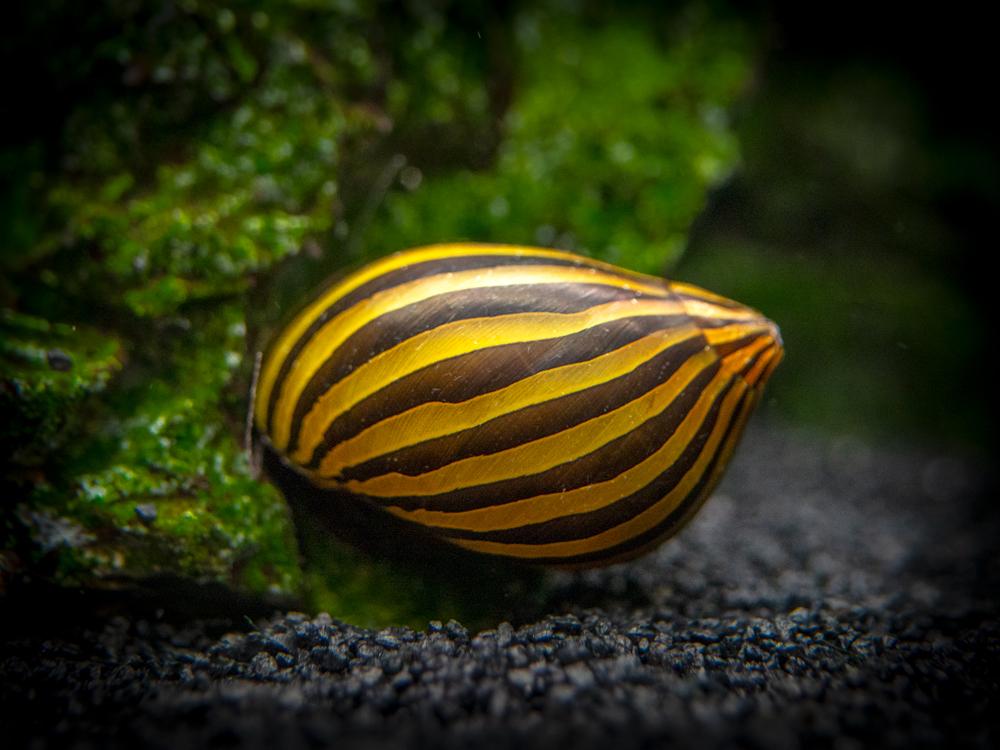
If you want lower-maintenance freshwater creatures for your tank, try Nerite snails. They will eat pretty much any algae, especially those on decor, driftwood, or on plants.
These snails are also great at removing green spot algae. In fact, it’s pretty much the only creature that’s able to do that.
If you’re worried about your snails reproducing and multiplying, don’t worry. Their eggs can’t hatch in freshwater conditions, so you won’t have a colony of them, but just the amount you added to your tank.
They’re also beautiful snails, so they add some aesthetic to your tank. You can choose from different colors and patterns, but olive Nerite snails are probably the best to keep in a freshwater tank.
3. Amano Shrimp
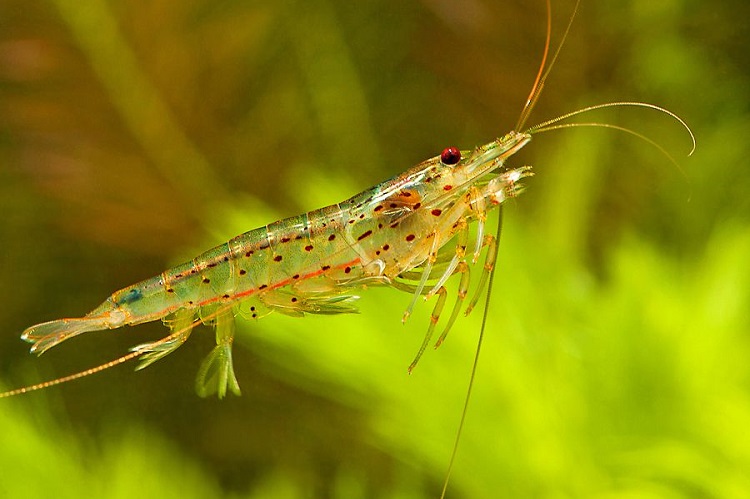
Try Amano shrimps if you want to add some variety to your freshwater tank and want efficient algae-eaters.
These are great to remove fuzzy algae and nimble-fingered algae. They’ll even eat hair algae and black beard algae, which is rare. Just make sure you don’t feed them too much, otherwise, they won’t eat as many algae.
Since Amano shrimp are really small, you’ll need at least four to remove the algae population.
4. Cherry Shrimp

If you just need preventative animals for your freshwater tank, try adding Cherry shrimp. They’re not as efficient as Amano Shrimp, but they’re great to prevent any excess algae or food build-up..
Cherry shrimp are especially good for picking through the substrate with their small limbs, as well as plant roots or any small crevices.
Just remember that these vibrant red-colored shrimp reproduce easily, so you can end up with a lot of them in your aquarium.
5. Bristlenose Plecostomus

Plecostomus fish are probably the most well-known freshwater tank algae eater. However, these are only suited for larger aquariums and require more care, so they won’t be for everyone.
Bristlenose Plecostomus are peaceful fish and have suckermouths that are meant to eat algae, literally vacuum any leftover foods, and to keep driftwood clean. They also look very unusual, and they’re great to watch!
6. Siamese Algae Eater

Crossocheilus oblongus, aka Siamese algae eater, is a small six-inch fish that is usually used in larger freshwater aquariums.
These fish have downturned mouths, which are perfect for eating black beard algae, hair algae, and leftover food scraps in a fish tank.
Younger Siamese algae eaters eat more algae than adults since bigger ones get a larger share of food in the aquarium. So if you want to make sure that your adult fish eat all the algae that’s in the freshwater tank, don’t feed them as much.
Unfortunately, these algae-eating fish can become a bit territorial, especially with their own species or similar ones. So we’d recommend you get either one or three. If you get three, you not only get a peaceful tank, but you also get an efficient clean-up team.
Best Saltwater Algae Eaters
Here are the best saltwater algae eaters for all types of aquarium sizes and different algae.
1. Mexican Turbo Snail
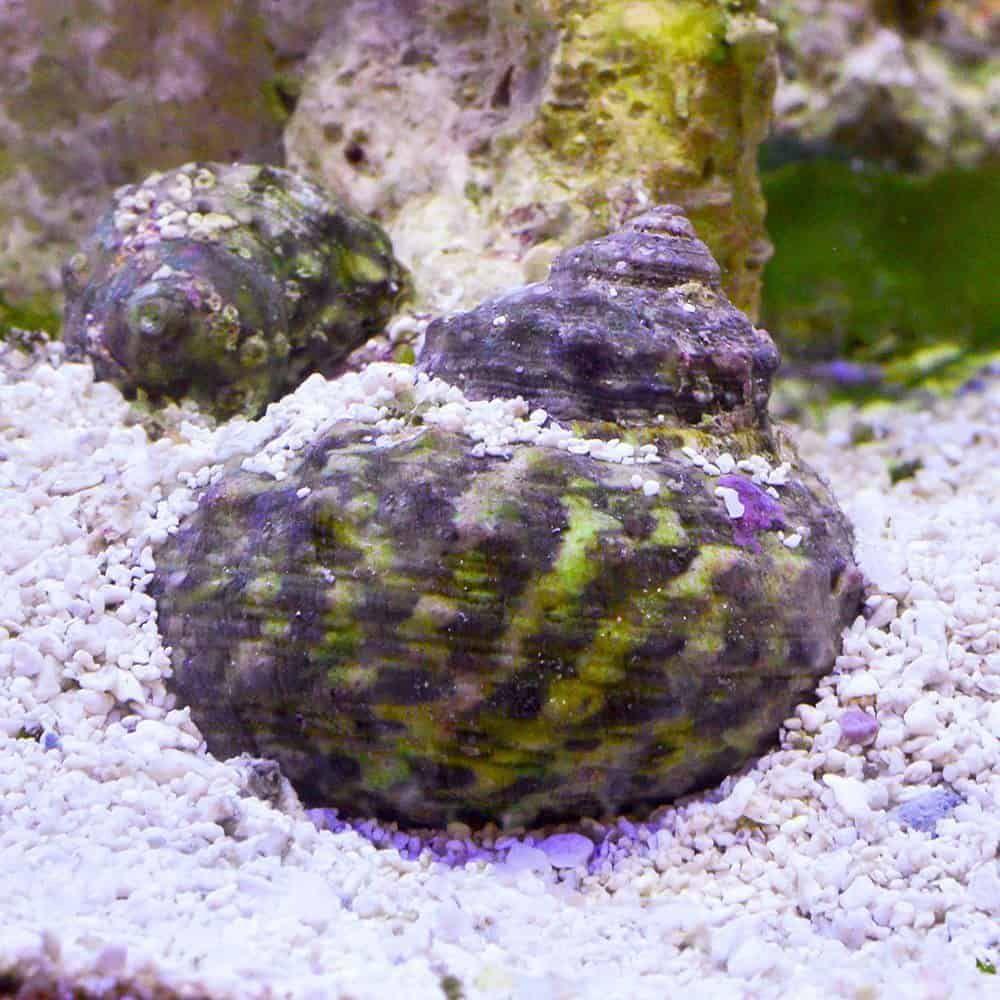
If you have algae problems in a large fish tank, try adding a Mexican turbo snail to it. The name of this snail makes it sound impressive, and that’s because it is.
It can mow down any type of algae in large aquariums, so it’s very useful. The Mexican turbo snail can also size up, and that can be a problem for smaller tanks. You need to add it to at least a 10-gallon saltwater tank.
This snail can also flip itself, so you can add it to a crab tank without any problem. The shell of the snail is too hard for a crab to attack or eat it.
The other advantage of these powerful snails is that you don’t need to add a lot of them to your tank to get it clean.
So this snail is a great addition to large aquariums, as it will eat pretty much any type of algae. That’s why it’s our first recommendation.
2. Kole Tang

If you have a larger saltwater tank, let’s say at least a 70-gallon one, and you need to get rid of film algae, try adding a Kole Tang fish.
Sometimes, Kole Tang fish can even eat macroalgae and hair algae. Also, this fish species is a beautiful addition to any tank, no matter how big the tank. Kole Tang fish are also less aggressive than Purple Tangs, Yellow Tangs, or even Scopa Tangs.
Just be aware that their care level is medium and that they can sometimes be aggressive, but they work well to remove film algae.
3. Tailspot Blenny
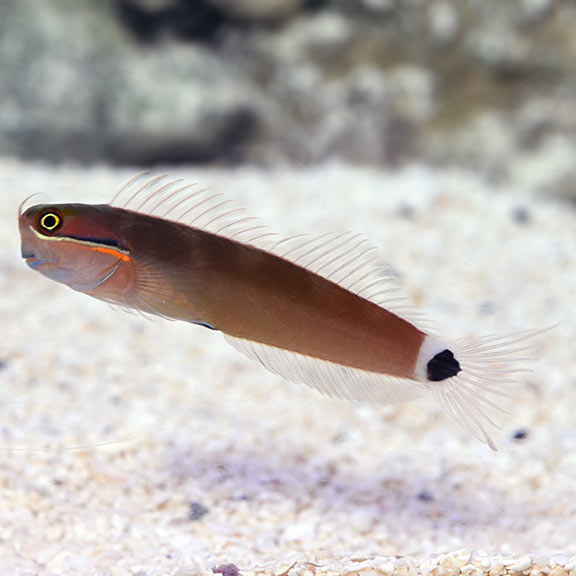
If you’re looking for an algae eater for a smaller saltwater aquarium, we’ve got you covered too. Tailspot Blenny fish are great, and they eat both; hair algae and film algae.
They also have a peaceful temperament and are easy to care for. So if you have a 10-gallon tank and want to remove hair algae or film algae, try to add this entertaining small fish to your saltwater aquarium.
They’re very fun to watch, and they’re efficient too, which is all you need!
4. Foxface

If you have at least a 75-gallon saltwater tank and have a problem controlling hair algae, try adding Foxface fish to it. In fact, you could even add a Kole Tang and a Foxface together, as they make a very efficient and thorough algae-eating team.
Foxface fish also eat most macroalgae, and they’re very resistant to bacterial infections.
Unfortunately, there are some cons to owning Foxface fish. First of all, their spikes are venomous and can grow really fast. They can also eat clams and corals, so they’re not compatible with most tank mates.
5. Cerith Snail

If you want mighty but small and peaceful creatures to add to your saltwater tank, consider getting Cerith snails.
These reproduce really quickly, and the more of these snails you have, the faster the algae disappears. Cerith snails can eat pretty much any algae, whether on glass, rock, or sand. They’re really impressive creatures and super easy to care for.
These snails are also very cheap, especially if you get them in large quantities. They are also perfect for nano reef tanks.
However, Cerith snails are so tiny that they can be sucked up in your overflow box. So if you have plumbing problems, be aware of that.
6. Emerald Crab
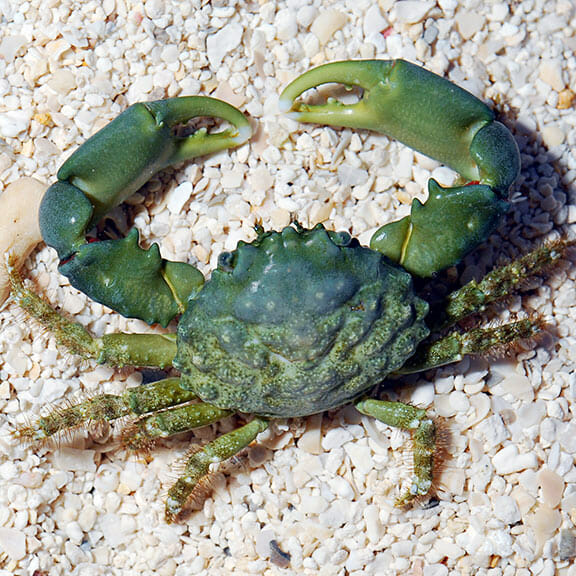
If you want to add some variety to your saltwater tank, you could also add an Emerald crab to it.
You might not know this, but Emerald crabs are great to eat bubble algae, but also hair algae and keep nutrient-reliant algae under control.
This type of crab is generally peaceful, but it can become a bit aggressive if you don’t feed it enough. Females tend to be less aggressive than male Emerald crabs, so we recommend you only get female crabs.
But if you have algae problems, especially with bubble algae, you can rest assured that everything will disappear if you add an Emerald crab to the tank. Also, this crab is really easy to take care of and remains peaceful if you feed it enough.
Choosing the Ideal Algae Eater Fish for Your Aquarium
Selecting the perfect algae eater fish for your aquarium is about finding the right balance for your specific tank environment.
For smaller aquariums, compact algae eaters like the otocinclus catfish are an ideal fit, while larger tanks can comfortably accommodate bigger algae eating fish like plecostomus.
It’s crucial to pick an algae eater that harmonizes with the size of your tank, ensuring it won’t outgrow its space. Equally important is ensuring that your chosen algae eaters are harmonious with the other fish in your tank.
Tips for Algae Eater Fish Care

Caring for your algae eater fish involves attention to detail and understanding their unique needs.
Regular water changes and testing are key to maintaining optimal water conditions, as most algae eaters thrive in soft, slightly acidic environments.
Provide them with ample hiding spaces and caves, as some prefer solitude while others can display territorial behavior. Be mindful of overcrowding, as this can lead to stress and aggression in your tank.
Feeding your algae eaters a balanced diet is essential. Opt for high-quality omnivore or herbivore foods, supplemented with algae wafers.
However, be cautious not to overfeed, as many algae eaters are voracious eaters. Cultivating natural algae in your tank can also provide them with a consistent food source.
Exploring Algae Eating Options Beyond Fish
While algae eater fish are a popular choice, don’t overlook other organisms that effectively control algae in aquariums. Snails, particularly nerite varieties, excel at cleaning algae from surfaces and décor.
Amano shrimp are also efficient, especially at tackling hair algae. Each option has its benefits and limitations – fish can consume more algae but might require larger spaces, whereas invertebrates like shrimp and snails excel in smaller tanks but with limited algae consumption capacity.
Combining these two types can create an effective algae control team, with shrimp and snails handling detailed cleaning, and fish taking care of broader areas.
The Limitations of Relying Only on Algae Eating Fish

Depending solely on algae eaters for algae control can have its limitations. They may not completely resolve all algae problems. To support their efforts, consider reducing feeding, stepping up tank cleanups, and using algaecides judiciously.
Incorporate regular maintenance routines like gravel vacuuming, adjusting lighting periods, and manually removing algae. Remember, there’s no one-size-fits-all solution, so it’s best to use algae eating fish as part of a comprehensive algae management strategy.
Selecting Plant-Friendly Algae Eaters for Planted Tanks
If you have a planted aquarium, it’s essential to choose algae eaters that coexist peacefully with your live plants.
Suckermouth catfish, such as otocinclus, are an excellent choice since they focus solely on consuming algae. Be wary of certain plecos and other herbivorous fish that may uproot or eat your plants.
Research is key to finding species that either benignly coexist with or actively benefit your aquatic plants. Nerite snails are particularly effective, cleaning algae from leaves without causing harm, while shrimp like amanos can help control algae and contribute to plant health by eating debris
Final Thoughts
Hopefully, you can find the perfect addition to your freshwater or saltwater tank. There’s plenty of options to choose from, as you can see above.
It doesn’t matter what kind of algae problems you’re facing, snails, fish, or crabs can eat them and leave you with a beautiful and clean tank!

Ian Sterling, founder of Fishlab.com, began his aquarium journey over 30 years ago, driven by a deep fascination for fish and their diverse personalities. His website, Fishlab.com, is dedicated to making fishkeeping accessible and enjoyable, offering beginner-friendly guidance, expert insights, and a community for aquarists to connect and share experiences.

